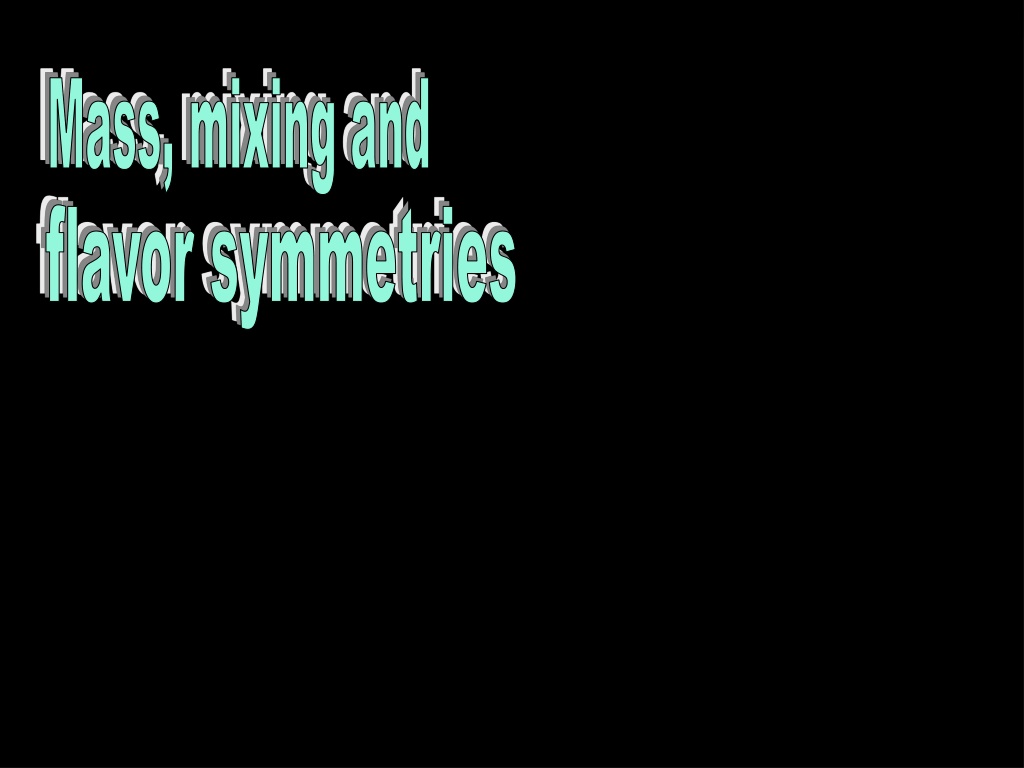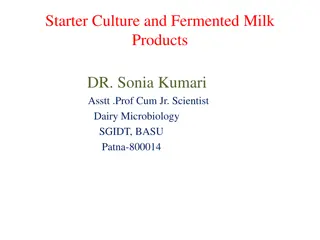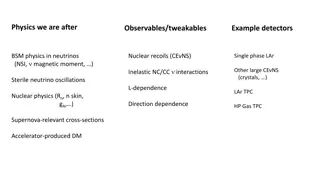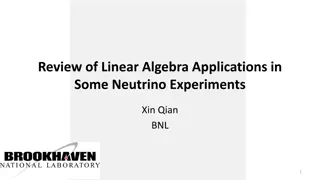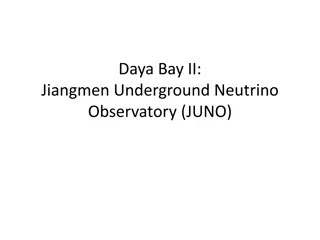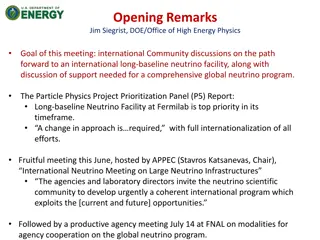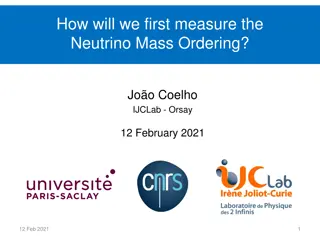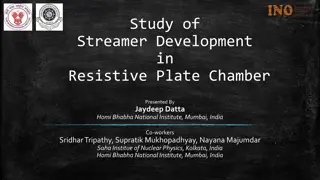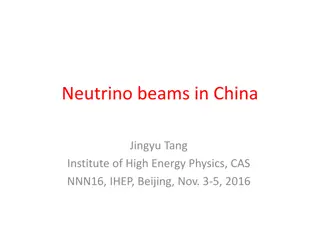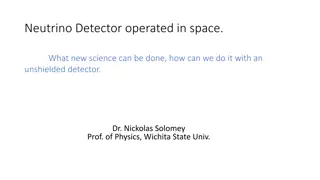Understanding Neutrino Mass, Mixing, and Flavor Symmetries
Neutrino physics involves studying mass, mixing, and flavor symmetries, which present new challenges when dealing with multiple neutrinos. The discussion includes neutrino states, mixing matrices, flavor content, vacuum mixing, standard parametrization, mixing angles, global fits, and the Tri-bimaximal mixing model by Harrison, Perkins, and Scott.
Download Presentation

Please find below an Image/Link to download the presentation.
The content on the website is provided AS IS for your information and personal use only. It may not be sold, licensed, or shared on other websites without obtaining consent from the author. Download presentation by click this link. If you encounter any issues during the download, it is possible that the publisher has removed the file from their server.
E N D
Presentation Transcript
Mass, mixing and flavor symmetries
Three neutrinos and three problems New problems appear when there are more than 1 object three neutrinos Mixing Relative CP phases Mass ordering Mass ratios type of spectrum
Flavors and mixing Flavor neutrino states: Mass eigenstates 1 2 3 e m1 m2 m3 e Mixing Flavor states Weak interaction states Mass eigenstates Flavor states Combinations of mass states described by mixing matrix UPMNS f = UPMNS mass
Mixing: dual role e |U 3|2 |U 3|2 3 |Ue3|2 mass |Ue2|2 2 1 |Ue1|2 e Flavor content of the mass states mass = UPMNS + f Mass content of the flavor states f = UPMNS mass
Vacuum mixing f = UPMNS m Ue1 Ue2 Ue3 U 1 U 2 U 3 U 1 U 2 U 3 1 2 3 e =
Standard parametrization IM UPMNS = U23I U13I U12 I = diag (1, 1, ei ) Dirac phase matrix 1 0 0 0 c23 - s23 c13 0 s13e-i 0 1 0 c12 s12 0 -s12 c12 0 IM 0 -s23 c23 -s13ei 0 c13 0 0 1 i 21 /2 i 31 /2 IM = diag (1, e , e ) - matrix of Majorana phases Not unique parametrization Convenient for phenomenology, especially for oscillations in matter Insightful for theory?
Mixing angles e Mixing parameters |U 3|2 |U 3|2 3 tan 12 =|Ue2|2 / |Ue1|2 |Ue3|2 sin 13 = |Ue3|2 MASS2 tan 23 = |U 3|2 / |U 3|2 m231 |Ue2|2 2 1 m221 Mixing matrix: |Ue1|2 FLAVOR f = UPMNS mass Normal mass hierarchy 1 2 3 e = UPMNS m231 = m23 - m21 m221 = m22 - m21 UPMNS = U23I U13I U12
Data. Global fit NO preference smaller than 2 Octant? With SK atmospheric lower octant is preferable NO: CP-phase close to
TBM: deviations and implications P. F. Harrison, D. H. Perkins, W. G. Scott Tri-bimaximal mixing 2/3 1/3 0 - 1/6 1/3 - 1/2 - 1/6 1/3 1/2 Utbm = U23( /4) U12 sin2 12 = 1/3 Utbm = Accidental, numerology, useful for bookkeeping Not accidental Lowest order approximation which corresponds to weakly broken (flavor) symmetry of the Lagrangian Accidental symmetry (still useful) There is no relation of mixing with masses (mass ratios) with some other physics and structures associated flavons other new particles
Mass hierarchies mh > m312 > 0.045 eV at mZ up down charged neutrinos quarks quarks leptons 1 m2 m3 m212 m322 10-1 ~ 0.18 10-2 mass ratios Neutrinos have the weakest mass hierarchy (if any) among fermions 10-3 10-4 Related to large lepton mixing? Koide relation 10-5 mu mt = mc2 sin C ~ md/ms Gatto Sartori-Tonin relation
Mixing and mass matrices Origin of mixing: off-diagonal mass matrices Ml = M Mixing matrix Diagonalization: Mass spectrum M = U Lm diag U LT m diag = (m1, m2, m3) Ml = UlLmldiag UlR+ mldiag = (me, m , m ) l (1 - 5) UPMNS mass CC in terms of mass eigenstates: UPMNS= UlL+ U L Flavor basis: Ml = mldiag UPMNS= U L
Decoupling of masses and mixing equalities, zeros Shape invariance Relations between elements Mixing Mass matrix of neutrinos (in the flavor basis) Absolute values of matrix elements Masses Opens up a possibility that symmetry is behind TBM Decoupling is always possible, but the key is that relations should be simple to be consequences of simple symmetries
Relations and symmetries Mixing: very special structure which is not related to mass ratios For TBM: m12 = - m13 , m22 = m33 , m11 + m13 = m22 + m23 S4 , sin C m12 = (m11 - m22) 1 2 sin2 C For Cabibbo mixing: ~ 1/4 Relation between matrix elements which leads to Cabibbo mixing independently of values of matrix elements symmetry which produces the relation dihedral D14 C. Hagedorn, 1204.0715
Mass Ordering e 3 2 m221 1 MASS2 MASS2 m223 m232 2 1 m221 3 FLAVOR FLAVOR Inverted mass ordering Normal mass ordering
Theories of mass ordering Accidental: selection of values of parameters Fundamental: principle, symmetry m2 m3 m m but 1-2 mixing strongly deviates from maximal m212 m322 m212 m322 m2 m3 ~ = 0.18 ~ = 1.6 10-2 ~ Similar to quark spectrum Flavor symmetries Quark-lepton symmetry Unification
Pattern of mass matrices For Majorana neutrinos Inverted hierarchy Normal hierarchy 21 = 0 Value of mass 21 = Strong dependence of structure of mass matrix on the Majorana phases - different patterns different possible symmetries For two different Majorana phases
Predicting mass hierarchy In models with residual (discrete) flavor symmetries mixing does not depend on mass at least in the symmetry limit. The same mixing pattern can be obtained for NH and IH Radiative mechanisms have different preferences those which are related to charged leptons prefer NH broken (Le L L ) symmetry - IH Seesaw type I with quark-lepton analogy (symmetry) leads to NH Establishing NH would favor the line with similarity with quark sector, high scale seesaw, etc. If so, one would expect the first quadrant,
Mixing and symmetries with intermediate possibilities
Realizations, problems Simple groups like S4 , A4 x Z2 can establish equalities of elements of mass matrix required by TBM
Deriving the TBM symmetry C.S. Lam Invariance of mass matrices in the flavor basis: ViT mTBM Vi = mTBM Neutrinos Vi = S, Ui 1 0 0 1 0 1 0 0 0 -1 2 2 -1 2 .. -1 1 3 -permutation S = U = charged leptons diagonal due to symmetry 1 0 0 2 0 T = = exp(-2i /3) T+ (me+ m e)T = me+ m e S, T, U elements of S4
S symmetry 4 Order 24, permutation of 4 elements Symmetry of cube Generators: S, T S4 = T3 = (ST2)2 = 1 Presentation: Irreducible representations: 1 , 1 , 2, 3, 3 3 x 3 = 3 x 3 = 1 + 2 + 3 + 3 Products and invariants New flavor structure 3 x 3 = 1 + 2 + 3 + 3 1 x 1 = 1 2 x 3 = 2 x 3 = 3 + 3 2 x 2 = 1 + 1 + 2 1 x 2 = 2
Residual symmetries approach E. Ma, C. S. Lam .... Mixing appears as a result of different ways of the flavor symmetry breaking in the neutrino and charged lepton (Yukawa) sectors. T S4 A4 Gf T7 S Residual symmetries of the mass matrices Z2 x Z2 or Z2 Gl Ml T G M U, S Zm Intrinsic symmetries of mass matrices which do not depend on values of masses Symmetry transformations in mass bases S M S T = M Discrete finite groups Flavons to break symmetries CP-transformations can be added
Intrinsic symmetries Realized for arbitrary values of neutrino and charged lepton mass can not be broken, always exist In the mass basis for charged leptons for Majorana neutrinos m = diag( m1, m2, m3) ml = diag( me, m , m ) G Gl i e i i T = diag(e , e , e ) = 2 k /m S1 = diag (1, -1, -1) S2 = diag (- 1, 1, -1) Tm = I Zm Si2 = I Z2 x Z2 The Klein group can use subgroup = 0 Intrinsic symmetries as residual symmetries
Invariance m1 m2 m3 1 2 3 1 2 3 Si
Symmetry group condition D. Hernandez, A.S. 1204.0445 If intrinsic symmetries are residual symmetries of the unique symmetry group (follow from breaking of unique group) bounds on elements of mixing matrix Si and T are elements of covering group. By definition product of these elements (taken in the same basis) also belongs to the finite discrete group: ( UPMNS Si UPMNS+ T)p = I p -integer For each i the equation gives two relations between mixing parameters Two such equations for i = 1,2 fix the mixing matrix completely TBM TBM Z2 x Z2 In general, the condition allows to fix mixing matrix up to several possibilities
A4symmetry E. Ma G Branco, H P Nilles Symmetry group of even permutations of 4 elements Symmetry of tetrahedron A4 Generators: S, T Presentation of the group: no U = A S2 = 1 T3 = 1 (ST)3 = 1 Irreducible representations: 3, 1, 1 , 1 Products and invariants 3x3 = 3 + 3 + 1 + 1 + 1 1 x 1 ~ 1
A_4 symmetry breaking A4 ``accidental symmetry due to particular selection of flavon representations and configuration of VEV s T S Ml diagonal M TBM-type In turn, this split originates from different flavor assignments of the RH components Nc and lc and different higgs multiplets
An A4model G. Altarelli D. Meloni symmetry Yukawa sector mass terms A4 Z4 1 i -1 -i Charged lepton Neutrinos 3 L L 1 n k i i Hd Hu T 1 at multiplets i Nc i 1 lc i -1 1, i, -1 1 flavons M S n = 1, 2, k = 0, 1 1 1 T = v S(0, 1, 0) S = v S (1, 1, 1) Flavon sector U(1)R Particular selection of representations Vacuum alignment 0 S S0 T T 0 0 Driving fields GUT-scale or higher? 2 -1 1 1
Generic problem m = F(Y, v) Mechanism of mass generation VEV s Yukawa couplings VEV alignment - different contributions - high order corrections TBM follow from independent sectors: Scalar potential Yukawa sector tune by additional symmetries All these components should be correlated ``Natural consequence of symmetry? one step constructions do not work
More problems No connection to masses Mass hierarchy from additional symmetries U(1) Froggatt- Nielsen mechanism n power n is determined by U(1) charges of the corresponding operators Discrete symmetries restricted possibilities to explain mass spectrum (degenerate, partially degenerate spectra) Missing representations problem
Relating to mass degeneracy Symmetry which left mass matrices invariant for specific mass spectra: Partially degenerate spectrum m1 = m2 , m3 Transformation matrix S = O2 D. Hernandez, A.S. G = SO(2) x Z2 m1 m2 Relation: sin22 23 = +/- sin = cos = = 1 maximal +/- /2 Majorana phase 1-2 mixing is undefined Small corrections to mass matrix lead to 1-2 mass splitting and 1-2 mixing
CP-violation, phase Certain values of follow from the flavor symmetries without additional assumptions Non-trivial CP phase : from generalized CP transformations when also flavor is changed
Flavor and CP symmetry Gfx HCP T A4 S4 Flavons (96) (48) Residual symmetries of the mass matrices G x H CP (27) Glx HlCP Sn D M R. Mohapatra, C C Nishi, F. Feruglio, C. Hagedorn, R. Ziegler, E Ma, G-J. Ding, S.F. King, C. Luhn, A. J. Stuart, Y-L. Zhou, Ml no CP violation = 0 G = Z2 x Z2 G = Z2 usually = 0, +/- /2 C. Hagedorn, et al may depend on free parameter and take any value Y. Farzan, A.S.
Modular symmetries as flavor symmetries F. Feruglio Gui-Jun Ding, S.F. King, Xiang-Gan Liu, S. Petcov, A V. Titov, M. Tanimoto , T. Nomura, H. Okada, T Kobayashi, O.Popov Y. Shimizu, P Novichkov, J. Penedo, T Osaka, A. Romanino, I. De Medeiros Varzielas, X Wang, S. Zhou ... Motivated by string theory Symmetry related to (orbifold) compactification of extra dimensions and primary realized on the moduli fields which describe geometry of the compactified space. Hope was to Reduce number of parameters, more predictive - ? Connect masses and mixing - ?
Modular symmetries For single modulus field the modular transformation a + b c + d = The 2x2 matrices of integer numbers a b c d with determinant ad bc = 1 form the group = SL(2, Z) [special, linear, integer ...] Modular group N is finite subgroup of , quotient group of the level N: N = ( ) Isomorphic to the groups considered previously: 3, 4, 5 are isomorphic to A4, S4, A5, correspondingly
Modular group N In SUSY, the chiral superfields transform as ,. kI I (c + d) ( ) I kI is the weight of multiplet ( ) is the representation of element of the group N Appearance of the weight factor in transformations is new element which leads to new consequences
Modular forms - another key element of formalism fi( ) - holomorphic functions of modulus field Transformation properties are similar to those of superfields fi( ) fi( ) = (c + d) ( )ij fj( ) kf fi( ) form multiplet of N whose dimension is determined by level N and weight kf For instance for N = 3 and kf = 2, fi form triplet with components Y1( ) = 1 + 12q + 36q2 + ... Y2( ) = - 6q1/3 (1 + 7q + ... ) Y3( ) = - 18 q2/3 (1 + ... ) i2 q = e = 0.0117 + i 0.995 Yi = (1, - 0.74, - 0.27) Data fit: weak hierarchy
Yukawa couplings are modular forms - holomorphic functions of modulus field - Form multiplets of the group N and transform as superfields: k Yi( ) Yi( ) = (c + d) ( )ij Yj( ) k is the weight of multiplet ( ) is the representation of element of the group N dimension of the multiplet is determined by the level N and weight k they are fixed by symmetry Dependence Yi( ) is determined by transformation properties
Invariant superpotentials Invariance of terms of the superpotential Y 1 2 3 - constant requires for product of representations 1x 2 x 3 x Y = I ki + kY = 0 for weights The latter condition acts to some extent as Froggatt- Nielsen symmetry it gives additional restrictions, forbids some term texture zeros
Models J Griado and F. Feruglio 1807.01125 [hep-ph] flavon L Ec Nc Y A43 1, 1 , 1 3 3 3 k 1 -4 -1 2 3 Y lowest order modular form and are fixed by fitting on m3 /m2, 1-2 mixing and 1-3 mixing Predictions: sin 2 = 0.46 / = 1.434 / = 1.7 / = 1.2
Gui-Jun Ding, S.F. King, Xiang-Gan Liu 1907.11714 [hep-ph] Models No flavons Flavor from single modulus field Higher order modular forms Y(2), Y(4) , Y(6) constructed as products of Y(2) All Yukawas are modular forms L Ec Nc Y A43 1, 1 , 1 3 3 k 2 2 0 -2 is fixed by fitting 12 mixing and 13 mixing Predictions: m1 = 0.0946 eV m2 = 0.0950 eV m3 = 0.1071 eV Normal ordering mee = 0.095 eV sin 2 = 0.58 / = 1.6 / = 0.15 / = 1.00 Cosmological bound?
From Model building to Symmetry building Minimal simpest versions do not reproduce data well. Generic predictions of masses: weak hierarchy, often quasi-degenerate, Majorana CP-phases Several moduli, flavons, More parameters needed. Different representations of the same dimension, fine tuning of corresponding couplings Different ways of construction of finite groups In the end: # parameters is comparable to # of observables Use modular symmetry in wrong way?
Modular vs. usual discrete symmetries Comparing with usual approach with flavons Y1 (< >) , Y2 (< >) ... Yn (< >) < 1>, < 2>, ... , < n> For a given N, k, Y - known functions of the same VEV - Flavon VEV s depend on parameters of potential and not controlled by symmetry. Independent for different representations Can do the same as modular symmetry constructions
Comparison F. Feruglio and A. Romanino, Rev. Mod. Phys. 93 (2021), 1. 015007 1912.0602 Usual Yukawa coupling Y L Nc Hu Y -constant Linear traditional flavor symmetry flavons (dimensionless) transformation under G flavor symmetry group: i(g) L L(g) L, Nc N (g)Nc Invariance: L(g) N(g) i i(g) contains singlet Y i L Nc Hu Y Y, Modular symmetry All the factors including coupling transform as f( ) (c + d) f( ) f( ) Invariance: f f(g) contains singlet and kf Y( ) L Nc Hu f kf = 0 Y i Y( )
Eclectic flavor symmetry H.P Nilles, A.Baur, S. Ramos- Sanchez, P.K. Vaudrevange, A. Trautner.. Explicit top-down construction from heterotic string theory compactified on orbifold T2 /Z3 All symmetries used in bottom up approach: Gtraditional , Gmodular , GR , CP Z2CP CP transformations Z9R discrete R symmetry appear simultaneously in non-trivially unified fashion Kahler potential (kinetic terms) is involved and introduce additional parameters, freedom
